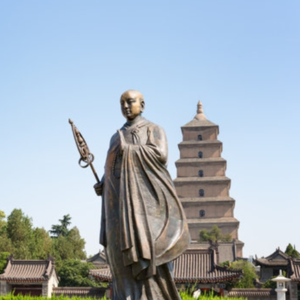今天我们来了解一下西游记的主人公 - 唐玄奘的一生。大家对于唐玄奘更多的印象是西游记中,历经磨难,终于取到佛经。但其实,玄奘在中国历史上有着不可磨灭的功绩,就让我们一起用英语,来了解一下玄奘的一生吧!
A Brief Overview of Xuanzang’s Life and Historical Milestones
1. Early Life and Vocation (602 – ~622 CE)
Xuanzang was born in 602 CE in Henan Province, China, during the Sui Dynasty. A precocious child, he was deeply drawn to Buddhism from an early age. After the death of his father, he became a novice monk at the age of 13, eventually becoming a fully ordained monk and dedicating himself to Buddhist study.
2. Motivated by Doubts – The Journey to the West (627 CE)
Dissatisfied with the contradictions in Buddhist texts available in China, Xuanzang resolved to travel to India, the birthplace of Buddhism, to seek original scriptures and deeper understanding. Despite an imperial travel ban, he secretly left Chang’an (modern Xi’an) in 627 CE, embarking on a perilous journey across deserts and mountains.
3. The Pilgrimage and Studies in India (~628 – 645 CE)
Xuanzang traveled through Central Asia and eventually reached Nalanda University in India, a great center of Buddhist learning. He studied under the renowned scholar Śīlabhadra and mastered various schools of Buddhism, especially Yogācāra (Consciousness-Only School). He spent over 17 years in India, collecting over 600 Buddhist texts and relics, while also engaging in scholarly debates and earning widespread respect.
4. Return to China and Translation Work (645 CE onward)
Xuanzang returned to China in 645 CE, receiving a hero’s welcome from Emperor Taizong of Tang. He brought back a massive collection of scriptures, statues, and relics. He then led a government-supported translation team at the Great Wild Goose Pagoda in Chang’an, where he translated over 70 volumes of Buddhist texts into Chinese, including the important Heart Sutra and Prajñāpāramitā texts. His translations are renowned for their accuracy and literary quality.
5. Authorship of the “Great Tang Records on the Western Regions”
In addition to his translations, Xuanzang authored the Great Tang Records on the Western Regions (Da Tang Xiyu Ji), a detailed and invaluable record of his travels, geography, and cultures of Central and South Asia. It became a key source for historians and geographers alike.
6. Legacy and Influence
Xuanzang passed away in 664 CE, but his influence lived on. He became an icon of scholarly devotion and cultural exchange. His journey inspired the 16th-century novel Journey to the West, where he is immortalized as the monk Tang Sanzang. Xuanzang is remembered as a symbol of spiritual dedication, intercultural exchange, and the pursuit of truth.



 45
45 0
0